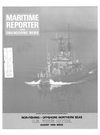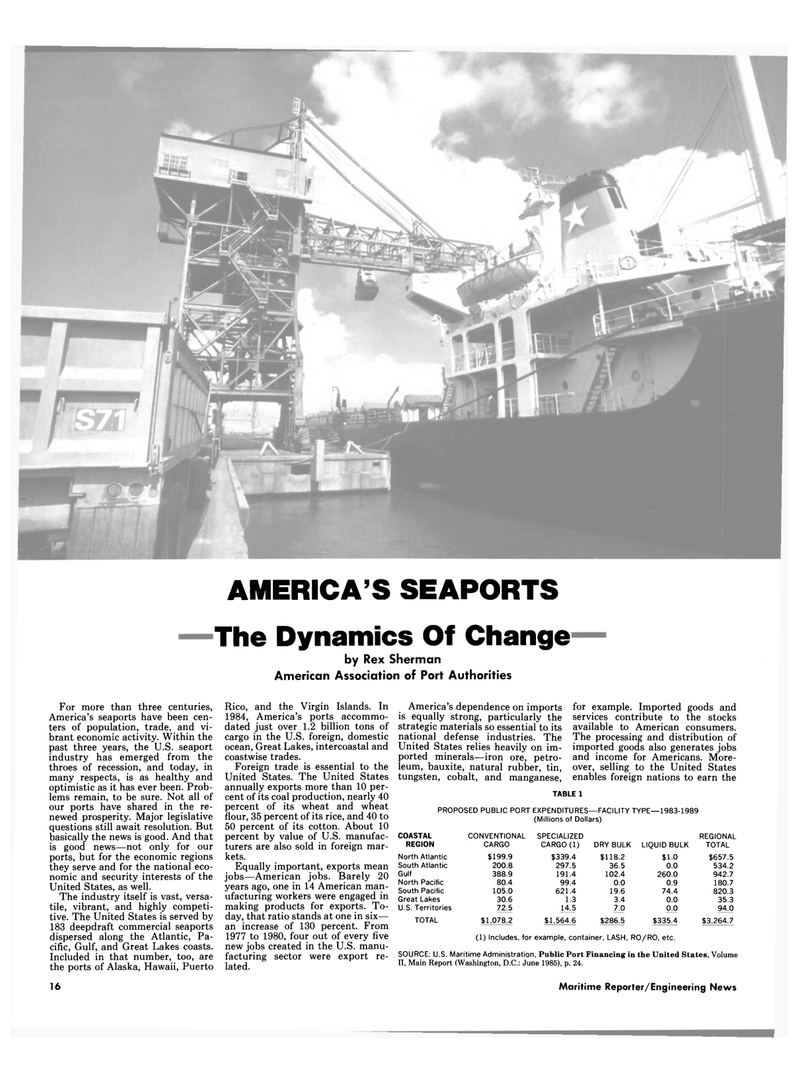
Page 14: of Maritime Reporter Magazine (August 1986)
Read this page in Pdf, Flash or Html5 edition of August 1986 Maritime Reporter Magazine
AMERICA'S SEAPORTS
The Dynamics Of Change by Rex Sherman
American Association of Port Authorities
For more than three centuries,
America's seaports have been cen- ters of population, trade, and vi- brant economic activity. Within the past three years, the U.S. seaport industry has emerged from the throes of recession, and today, in many respects, is as healthy and optimistic as it has ever been. Prob- lems remain, to be sure. Not all of our ports have shared in the re- newed prosperity. Major legislative questions still await resolution. But basically the news is good. And that is good news—not only for our ports, but for the economic regions they serve and for the national eco- nomic and security interests of the
United States, as well.
The industry itself is vast, versa- tile, vibrant, and highly competi- tive. The United States is served by 183 deepdraft commercial seaports dispersed along the Atlantic, Pa- cific, Gulf, and Great Lakes coasts.
Included in that number, too, are the ports of Alaska, Hawaii, Puerto
Rico, and the Virgin Islands. In 1984, America's ports accommo- dated just over 1.2 billion tons of cargo in the U.S. foreign, domestic ocean, Great Lakes, intercoastal and coastwise trades.
Foreign trade is essential to the
United States. The United States annually exports more than 10 per- cent of its coal production, nearly 40 percent of its wheat and wheat flour, 35 percent of its rice, and 40 to 50 percent of its cotton. About 10 percent by value of U.S. manufac- turers are also sold in foreign mar- kets.
Equally important, exports mean jobs—American johs. Barely 20 years ago, one in 14 American man- ufacturing workers were engaged in making products for exports. To- day, that ratio stands at one in six— an increase of 130 percent. From 1977 to 1980, four out of every five new jobs created in the U.S. manu- facturing sector were export re- lated.
America's dependence on imports is equally strong, particularly the strategic materials so essential to its national defense industries. The
United States relies heavily on im- ported minerals—iron ore, petro- leum, bauxite, natural rubber, tin, tungsten, cobalt, and manganese, for example. Imported goods and services contribute to the stocks available to American consumers.
The processing and distribution of imported goods also generates jobs and income for Americans. More- over, selling to the United States enables foreign nations to earn the
TABLE 1
PROPOSED PUBLIC PORT EXPENDITURES—FACILITY TYPE—1983-1989 (Millions of Dollars)
COASTAL CONVENTIONAL SPECIALIZED REGIONAL
REGION CARGO CARGO (1) DRY BULK LIQUID BULK TOTAL
North Atlantic $199.9 $339.4 $118.2 $1.0 $657.5
South Atlantic 200.8 297.5 36.5 0.0 534.2
Gulf 388.9 191.4 102.4 260.0 942.7
North Pacific 80.4 99.4 0.0 0.9 180.7
South Pacific 105.0 621.4 19.6 74.4 820.3
Great Lakes 30.6 1.3 3.4 0.0 35.3
U.S. Territories 72.5 14.5 AO 00 94.0
TOTAL $1,078.2 $1,564.6 $286.5 $335.4 $3,264.7 (1) Includes, for example, container, LASH, RO/RO, etc.
SOURCE: U.S. Maritime Administration, Public Port Financing in the United States, Volume
II, Main Report (Washington, D.C.: June 1985), p. 24. 16 Maritime Reporter/Engineering News

 13
13

 15
15
